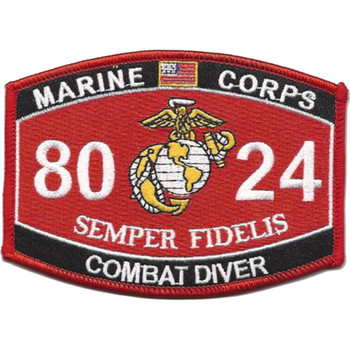Description
1371 Combat Engineer MOS Patch (U.S. Marines) 4.5" x 3.25" Embroidered Patch with Iron-On Backing
Superior Materials: Made with premium polyester thread and durable twill fabric, ensuring long-lasting color and strength.
Advanced Embroidery Technology: Crafted using the most advanced embroidery machinery, guaranteeing intricate detail, sharp lines, and consistent quality every time.
Easy Iron-On Application: Features a heat-activated adhesive backing for quick, no-sew attachment. Simply position, iron, and press for a secure bond.
Versatile Use: Perfect for personalizing jackets, backpacks, uniforms, or any fabric surface that needs a touch of personality.
Durable and Washable: Designed to withstand everyday wear and occasional washing without fading or fraying.
Formations & Origins
The 1371 Combat Engineer MOS is a vital role within the United States Marine Corps, specializing in providing essential engineering support on the battlefield. Combat Engineers have existed in various forms since the earliest days of military history, but the modern MOS 1371 was formalized to train Marines in construction, demolition, fortification, and mobility tasks under combat conditions. These engineers are trained to clear obstacles, build defenses, and enable the maneuver of friendly forces while hindering the enemy’s movement. Their expertise bridges the gap between infantry and engineering, making them indispensable in shaping the battlefield.
Notable Commanders
As an MOS rather than a standalone unit, 1371 Marines serve within engineer battalions and companies under a range of commanders. However, some renowned Marine Corps leaders began their careers in combat engineering, using the skills and tactical knowledge gained to ascend to higher command. Their leadership often emphasizes the integration of engineering assets with infantry operations, enhancing unit mobility and survivability. The success of many operations owes much to the coordination between combat engineers and commanding officers who understand their strategic value.
Major Campaigns/Operations
Combat Engineers with the 1371 MOS have been involved in every major Marine Corps conflict, from World War II island campaigns to the deserts of Iraq and the mountains of Afghanistan. In World War II, combat engineers cleared mines, built bridges, and constructed fortifications crucial to the island-hopping strategy.
During the Korean War, they played a key role in constructing defensive positions and clearing obstacles under fire. In Vietnam, 1371 Marines conducted jungle clearing, road construction, and base fortifications, often while under enemy attack.
In recent conflicts, 1371 Combat Engineers have been essential in route clearance, improvised explosive device (IED) detection and removal, fortifying forward operating bases, and supporting both offensive and defensive operations. Their skills in demolition and construction directly impact the safety and mobility of Marine forces.
Specialized Role/Equipment
1371 Combat Engineers are trained in a broad array of tools and weapons, ranging from hand tools and explosives to heavy construction equipment like bulldozers, cranes, and armored engineer vehicles. They employ demolition charges, mine detectors, and breaching equipment to remove or create obstacles.
Their combat role demands proficiency with rifles and machine guns, as they often work close to or in contact with enemy forces. Engineering vehicles such as the Assault Breacher Vehicle (ABV) provide armored support for clearing mines and obstacles in hostile environments.
Beyond combat tasks, 1371s build fortifications, bunkers, and defensive positions that protect troops and assets. They also construct facilities like bridges, roads, and helipads, enabling sustained operations in remote or difficult terrain.
Acts of Heroism
Combat Engineers frequently face extreme danger as they work ahead of or alongside infantry units. Numerous stories of heroism come from their willingness to expose themselves to enemy fire to clear mines, remove booby traps, or construct defenses vital to the survival of their comrades.
One notable example occurred in Iraq, where a 1371 Marine team under heavy enemy fire successfully cleared a route of multiple IEDs, saving countless lives and enabling a critical resupply convoy to reach isolated units. Their courage and technical skill under pressure earned them unit citations and personal awards for valor.
Throughout history, combat engineers have repeatedly demonstrated that their role requires both physical toughness and mental acuity, making them among the most respected and trusted Marines on the battlefield.
Legacy & Notable Achievements
The 1371 Combat Engineer MOS represents the perfect blend of combat readiness and technical expertise. Their ability to shape the battlefield through construction, demolition, and obstacle management directly contributes to Marine Corps operational success.
Their legacy includes innovations in breaching techniques, explosive ordnance disposal, and rapid construction under fire. The MOS continues to evolve with new technology and battlefield requirements, but the core mission remains: to enable friendly forces to maneuver freely while denying the same to the enemy.
Combat Engineers hold a proud place in Marine history, embodying adaptability, courage, and the spirit of “every Marine a rifleman” combined with specialized skills that save lives and win battles.







